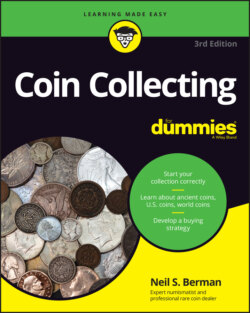Читать книгу Coin Collecting For Dummies - Neil S. Berman - Страница 22
Collecting versus Accumulating
ОглавлениеThe collecting instinct is a common trait among people; it shows up in many ways. You’ll discover that many of your friends are collectors of something. Who do you know who collects baseball cards, comic books, vinyl, Coca-Cola memorabilia, books, or dolls? Even people who claim to collect nothing probably have accumulations of something they haven’t even realized they’re accumulating — tools, newspapers, shoes, you name it. There’s a special comfort in collecting, in surrounding yourself with familiar objects and building a store of assets — perhaps in response to some primeval instinct that prepares you for a rainy day.
The allure of money is especially strong. Coins represent real value. Coins can be exchanged for other objects we desire. Coins travel throughout the world and through time itself, representing and absorbing history as they pass from one person to the next. Oh, the stories coins could tell if only they had voices! And they’re everywhere, because no one anywhere ever throws away old money.
Pull a dime out of your pocket, and what do you see? If all you see is 10 cents to spend, I’ve got a lot of work to do. But if you look at your dime and wonder at the artistic work of the engraver and the meaning of the symbols and the words, or if you see Franklin Roosevelt, the Great Depression, and the New Deal, groovy you’re hooked! You’re going to make a great coin collector and, perhaps, one day, a numismatist!
I make a distinction in this book between numismatists (those who study coins) and coin collectors (those who collect coins). You can be a numismatist without being a coin collector, you can be a coin collector without being a numismatist, or you can be both.
Not sure whether you have that collecting instinct? Here’s a great way to find out whether you’re an accumulator or whether you have the potential to become a coin collector:
1 Visit your local coin store or online, and purchase a folder made for pennies from the ’80s, ’90s, and 2000s.A folder is a cardboard holder with holes for every date.
2 Raid your change jar, or go to the bank and buy $20 worth of pennies.
3 Sort out the coins, and fill as many spotsholes as you can.If possible, find the best-looking coins to place in the folder.WHAT MAKES A COLLECTION COMPLETE?Completion is in the eye of the beholder. Many years ago, some coin collectors were interested only in collecting by date. Therefore, to be complete, a collection had to include one coin from every year that the coin was minted. Later, collectors developed an interest in mintmarks — the tiny letters that indicate where a coin was minted. Suddenly, to be complete, a collection had to include a coin from every year and from every mint. Then came collecting by variety (major or minor changes in the design of a coin), and the definition of completion expanded even further.Obviously, completion is an ever-changing standard. Taken to the extreme, the only complete collection of coins is one that includes every coin ever made! Striving for completion will drive you nuts. Instead, decide on your own goals, and set your own standards for completion. When you’ve completed that collection, consider a new definition of completion, and go for it! Remember: There’s no “correct” way to collect.
4 After you’ve gone through all the coins, sit back and take a look at your work.Do you wonder why some coins were harder to find than others? Do you wonder why you couldn’t find even a single example of some coins? Are you interested in completing the set? Did you have fun searching through the coins?If you answered yes to any of these questions, you’ve discovered the difference between being a collector and an accumulator — and in case you’re wondering, you’re a collector.
